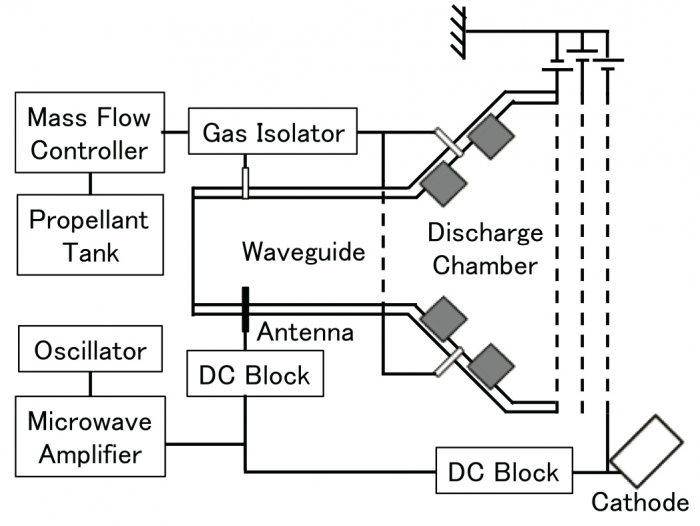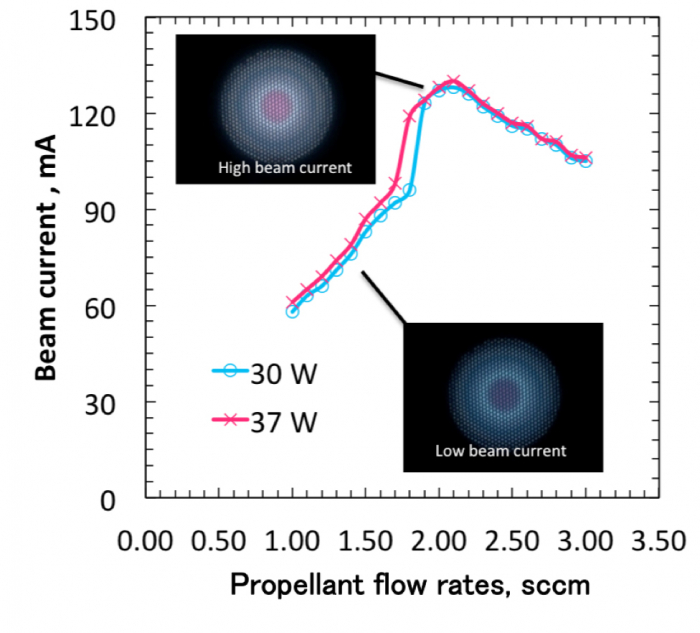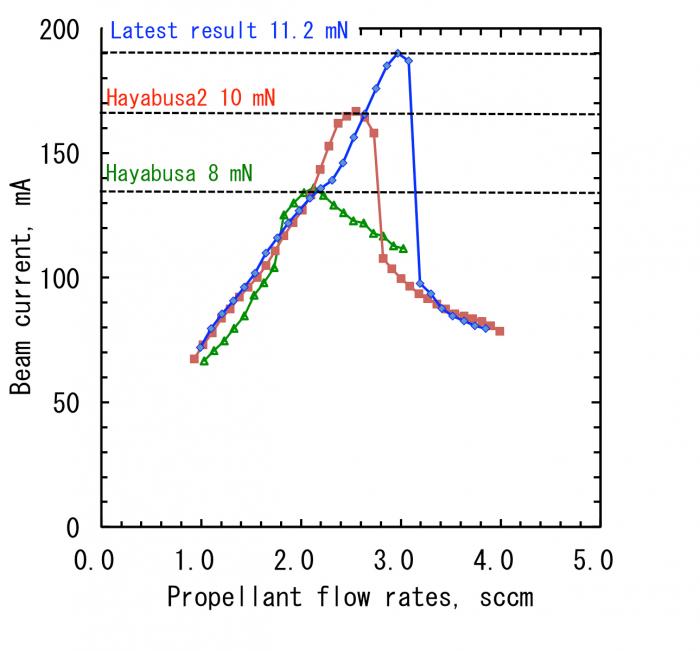Return of Hayabusa
On June 13, 2010, when the asteroid explorer Hayabusa returned to Earth, I was in a meeting room of the NASA headquarters in Washington DC, as an intern student from JAXA. Staff members who usually worked as coordinators with Congress and the White House and conducted political matters were watching the monitor with breathless interest, as if they were once again children dreaming about the space exploration. Just before leaving for the United States, I had been engaged in the Hayabusa mission to develop ion engines that would enable Hayabusa to conduct its journey and return to Earth. At the time, I did not understand English very well, had few achievements in my research, and had lost my confidence within a competitive atmosphere on the east coast and the overwhelmingly large scale of America and NASA. I remember that the news regarding Hayabusa allowed me to revive my pride as a Japanese researcher. In the same way that NASA staff members regained their childish innocence, I myself remembered my original intention in primary school, with an aim at deep space exploration.
The 1990s and 2000s when we grew up were hard times, as described through the expression "the lost 20 years," which refers to the 20 years following the economic collapse in Japan. Internationally, the Gulf War, Sept. 11 attacks, and other wars and terrorist acts had occurred, and the world was in a state of chaos. Growing up in those days with so much bad news, I became impressed by the beauty of the universe and the absence of borderlines on the Earth as seen from outer space through the Hubble Space Telescope, and after the first flight of a Japanese astronaut on the space shuttle, I decided to change the world through space research. In particular, I believed that an electric propulsion system that can drive a spacecraft farther with less fuel use is a technology that would change the world.
However, in 2008, when I entered ISAS as a graduate student, both Hayabusa and its ion engine were low terms of in performance, and never received a high evaluation among electric propulsion researchers. In addition, electric propulsion technology is unfortunately strictly controlled through the International Traffic in Arms Regulations (ITAR), and its research environment is very cramped for students and researchers who wish to study overseas and in a "world without borders." In this article for "Forefront of Space Science," I would like to introduce how the ISAS ion engine has been improved in an environment in which Japan has faced many international restrictions. In addition, I will also refer to a worldwide trend in electric propulsion technology.
10-cm-diameter ion engines
Among the different types of ion engines, ion engines of around 10 cm in diameter have been intensely developed worldwide. The microwave discharge system loaded on Hayabusa provided excellent durability by replacing a component called a hollow cathode (electron source), which conventionally limited its lifetime, with microwaves. The accumulative operation of four engines loaded onto Hayabusa, which was in space for 40,000 hours, had been the world record until September 2013, when the ion engine of NASA's asteroid explorer DAWN set a new record. However, these engines had a rather low efficiency and thrust force, which were weak points. If the thrust force is low, the long-term operation needs to supply the same acceleration amount, ΔV, and the degree of freedom in the orbit design and operation is also limited. Although a low thrust force and high specific impulse (good fuel economy) are characteristics of ion engines, an engine with a higher thrust force is preferable. In addition, at the time of launch, other types of ion engines, which had been regarded as having a short lifetime, were achieving a lifetime performance exceeding 10,000 hours, such as the NASA engine described above, thanks to improvements in the electron source, which had limited the lifetime thus far. Therefore, to ensure the superiority of microwave discharge ion engines, it was necessary to improve the life duration to a higher level that the other ion engines could not reach, while further securing the thrust force.
Principle and problem of microwave ion engine
Figure 1 shows a schematic view of the μ10 microwave discharge ion engine. A waveguide for propagating microwaves is connected to a discharge chamber. Two rows of strong magnets are installed in the discharge chamber. Electrons twirl around the magnetic force lines, and when their frequency coincides with the microwave frequency of 4.25 GHz, the electrons resonate and absorb the energy from the microwaves. If this movement continues between the magnets, the electrons absorb sufficient energy to ionize neutral xenon particles. This is called electron cyclotron resonance heating (ECR heating). To create plasma efficiently, it is necessary to make the electrons collide with the xenon atoms after they continue their repetitive motions up to a certain level to generate a sufficient amount of energy.
Figure 1: Schematic view of microwave discharge ion engine
Although a propellant was injected only from the waveguide in the case of Hayabusa, Hayabusa 2 had an additional propellant inlets in the discharge chamber.
Figure 2 shows the engine performance. Beyond a certain amount, even if the microwave power is increased or a large amount of xenon in the fuel is added, the beam current serving as an index of the thrust force does not change. In fact, if we add too much xenon, it decreases. What does this mean? We compared the same beam current between low and high xenon flow rates, as shown in the photograph in Figure 2, and noticed that the light emission at the center of the engine (red in particular) was strong. Just like astronomers who look at a star's color to judge its temperature, we can obtain various types of information by looking at the color of plasma. The radiation color of xenon ions is basically blue. A red color denotes the radiation of neutral xenon atoms excited by electrons that are unable to gain sufficient energy to ionize xenon atoms. Because we were only looking at the engine from the outside, we did not obtain any information in the depth direction. Therefore, we placed an optical fiber cable inside to actually measure the distribution of plasma, and identified that these events occur in the waveguide, instead of in the discharge chamber. The original role of the waveguide is to propagate microwaves into the discharge chamber. If the electrons collide with the xenon atoms in the waveguide, which should propagate them, the microwaves that are intended to reach the discharge chamber are not transmitted, and the thrust performance of the engine is deteriorated. We found such a problem during our continued research after the Hayabusa launch.
Figure 2: Beam current (proportional to thrust force) vs. xenon flow rate at 30-44 W of microwave power
Internal diagnosis and performance improvements of ion engine
To avoid this problem and further improve the performance of the engine, we considered that it would be effective to directly inject xenon between the magnets where electrons are repetitively moving, instead of supplying xenon from the waveguide. When we actually applied several patterns to the optimal supply method, the performance of the engine was improved, as shown in Figure 3, and the results were incorporated into the design of Hayabusa 2. In the engine of Hayabusa 2, the grid design (three broken lines in Figure 1) was also improved. It has been said that the holes of the accelerator grid should be designed as small as possible to improve the sealing performance of the gas, and that the screen grid should be as thin as possible to improve the ion extraction. Hayabusa 2 was improved in a relatively conservative manner. The US ion engine was designed to be extremely thin with small holes, and I therefore believe we can improve the grid a little further. For Hayabusa 2, a method for injecting propellant (improvement A), and two additional points, i.e., a conservatively thinned screen grid to maintain the strength, and an accelerator grid with a slightly smaller hole diameter (improvement B), have been adopted, and as a result, the thrust force has been improved by 25%.
Is there more room for improvement in an ion engine? As shown in Figure 2, a conventional microwave powered ion engine has shown no change in performance regardless of how much the microwave power or xenon flow rate of the fuel is increased. This is because the electrons remain in the waveguide. In fact, as a result of this solution, there is room for further performance improvement. It became clear during the last year that by electrically insulating the internal part of the ion engine and dividing it electrically, the destinations for the electrons and ions are limited, and the thrust force can be increased up to 11.2 mN without an increase in the microwave power (blue area in Figure 3). In addition, in October of last year, Yoshitaka Tani (the University of Tokyo), a research fellow DC1 of the Japan Society for the Promotion of Science, and others conducted shape optimization in a 1 mm unit, and achieved a thrust force exceeding 11.2 mN. Each of the components of an ion engine is complicated and made of special materials, and therefore cannot be changed easily with a research budget of only several million yen per year. However, thanks to the cooperation of Mr. Norio Okada, a member of the newly established Advanced Machining Technology Group of ISAS, many parts could be manufactured in-house at a cost of tens of thousands of yen.
Figure 3: Improvement results of microwave discharge ion engine
A beam current of 192 mA (thrust force of 11.2mN) was achieved with a microwave power of 34 W and flow rate of 2.9 sccm.
Lifetime limitation owing to ion sputtering
What about the average life span? In the case of Hayabusa, the neutralizer cathode dictates the lifetime limitation of the ion thruster system. To eject negatively charged electrons, it is inevitable for the walls to receive their counterparts, i.e., positive ions. When a wall receives ions, atoms on the wall surface jump out like billiard balls, and become sputtered. On the other hand, because the electron source for the neutralizer is also mandatory for a microwave discharge system, wear from the ions is inevitable. How to extend the lifetime of the electron sources used for both Hall thrusters and ion engines is one of the current research themes of electric propulsion technology. Even inside the electron source for the neutralizer, microwaves and magnets generate plasma similar to an ion source. On rare occasions, Xe2+(double charged xenon), in which two electrons are missing, is generated. During this research, it was determined that Xe2+, which exists only very rarely in the operation area of an ion engine, might wear the wall more heavily than the majority of Xe+(single charged xenon). Therefore, the suppression of Xe2+ generation is important for extending the lifetime of the neutralizer. Collisions with xenon atoms during a phase in which not much energy has yet been obtained can suppress the generation of Xe2+ more efficiently when microwaves accelerate the electrons. Therefore, for Hayabusa 2, the flow rate of xenon placed in the neutralizer is increased by about 40% so as to suppress Xe2+ generation. In a ground durability test that preceded the launch, a record of 40,000 hours, which is far greater than the 15,000 hours reached by Hayabusa, was achieved as of the end of March 2017, and the test is still ongoing.
International competition of electric propulsion technology
As can be seen, even after launching of Hayabusa and Hayabusa 2, studies on electric propulsion technology are continuously underway by researchers and students of ISAS within a limited budget. Although these researches have a certain number of scaling rules and common plasma physics factors, they contain many engine-specific factors, and there are many techniques that are not described in papers. I myself came to UCLA in the U.S. for a long-term (one-year) overseas training in September 2016. Although there are restrictions on ITAR even at UCLA, the degree of freedom has increased compared with my period as an intern at NASA. Here, small DC discharge ion engines and large current hollow cathodes are being studied, and I hope I can absorb knowledge that can only be acquired through actual work experience, and utilize such knowledge for future research activities. The United States is currently planning to capture a 10 ton class asteroid using a 50 kW electric propulsion device, and take it to the Earth's gravity zone to be used as a base for manned asteroid exploration. In addition, Space X plans to launch an electric propulsion satellite bus in 2017. Because the activities of these companies have not been publically documented, I have collected information on them by relying on a network that I have built on site.
Since the beginning of its practical application in the 2000s, electric propulsion technology has produced the following results, in addition to the asteroid sample returned by Hayabusa, which was a first in human history.
- The Artemis satellite, which failed to reach a geosynchronous orbit, was rescued and put into orbit by using an ion engine (European Space Agency).
- All-electric propulsion satellite equipped with a Boeing ion engine allowed a 50% weight decrease for a geosynchronous satellite, which realized "dual launch" (the cost for launching a 2 ton geosynchronous satellite is less than 3 billion yen/unit, according to Space X's Falcon 9, USA).
- With an ion engine, an ultra-low altitude Earth orbiting satellite, GOCE, was realized by compensating the atmospheric friction at an altitude of 200 km, which was previously unreachable (European Space Agency).
In various countries around the world, electric propulsion technology has led to the creation of technological innovations, the core technologies of which are controlled by ITAR to avoid being leaked to other countries. In order to establish electric propulsion technology in Japan, it is essential for Japanese engineers to put Hall thrusters into practical use on their own, following ion engines, and to create satellite buses, which are consistently expected to have a certain amount of demand. As seen in the examples of Hayabusa and Hayabusa 2, Japan has developed its electric propulsion technology in a ten-year cycle. We must not let the technology fade away over the next several years but advance it to maintain a steady technological capability, and we are currently at a crossroads.
(Ryudo Tsukizaki)
ISAS News: November 2016 issue



